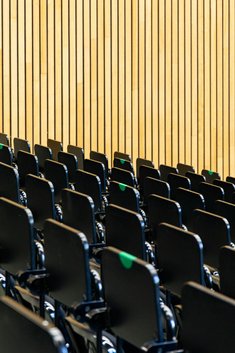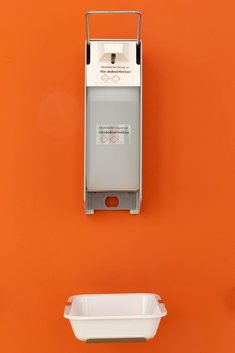Which rooms will be used for studying and teaching in the autumn and winter?
The winter semester starts up in three weeks and things on campus at the Bauhaus-Universität Weimar are still pretty relaxed. The changes that are being made to prepare for a winter semester under pandemic conditions are, on the surface, nearly invisible. However, these changes will be noticeable when students return to Weimar and courses begin on 2 November.
The first major change is the new room capacities. This means that the number of people allowed to be in rooms together at any given time is much lower. This is the only way to ensure that students and instructors can discuss and debate designs, texts, calculations and other matters in one room together while still »at a distance« from one another. Over many weeks, a team carefully calculated the necessary seating plan according to distancing regulations for each room, ensuring that there is 1.5 metres between each person in the room. »We want to make sure that students and staff are safe«, explains Maximilian Merkel, who is in charge of this aspect in the Bauhaus-Universität Weimar Koordinationsgruppe Corona (corona coordination group). »We have also taken hallways and corridors into account so that everyone will have enough space«, he continues.
All seats that can be used in lecture halls, for instance, have been marked with a green dot. Seating in seminar rooms has been specified and cannot be changed. Clear, mandatory rules have been established for the seats that can be used and the faculties have also come up with practical solutions.
In-Person Teaching at a Distance: An Organizational Challenge
With this in mind, all of the more than 150 classrooms have been prepared in the best possible way. However, because significantly fewer people are allowed in the classrooms, this has been challenging for the organisation of courses. Seminar rooms that typically accommodate up to 30 students are now only able to accommodate 10. Lecture halls, normally able to seat 190 people, are restricted to 24. And the Audimax which normally holds 450 people is now only allowed to seat 45.
Still, the University Directorate hopes to accommodate as many in-person courses as possible. The conditions are promising: Teaching is typically carried out in small groups at the Bauhaus-Universität Weimar, and there are no mass lectures with hundreds of students. Rooms have been rented off-campus in Weimar for courses with over 50 participants. The rest will take place online as it did in the summer semester.
The complete course catalogue can be found here : www.uni-weimar.de/vlv

Regular Airing to Prevent the Build-Up of Airborne Particles
In addition to lowering the maximum number of participants for in-person events, another important aspect this semester is the regular airing out of rooms. The University Directorate has sought the advice of Prof. Conrad Völker, Professor of Building Physics in the Faculty of Civil Engineering and expert on indoor climate. »The accumulation of airborne particles and the potential viral load can only be prevented by the regular and proper airing out of rooms«, says Prof. Völker. He places particular importance on cross ventilation, where doors and windows on opposite sides of the rooms are opened and rooms are aired out for three to five minutes. Seminar rooms should be aired out every 20 minutes and offices every 60 minutes.
But how can we get everyone on board with regular ventilation? Doesn't everyone have a different cold tolerance? In order to address the issue of how often rooms need to be aired out, rooms that are heavily trafficked have been outfitted with CO2 meters. These meters measure the levels of CO2 and emit a signal when the concentration of airborne particles is too high. They switch from green to yellow and emit a sound when rooms need to be aired out. This alerts those present to the latest point at which airing out is necessary. Some lecture halls have been outfitted with Raumlufttechnische Anlagen (ventilation systems), which provide a constant exchange of fresh air. Windows may not be opened in rooms outfitted with this system, or the system will automatically shut off.
While moving between rooms, be sure to follow distancing regulations, wear a mask, and disinfect often.
And what other changes can be expected in university buildings this autumn? The many bottles of disinfectant and disposable wipes in rooms for students to use before each event are obvious. Routes and corridors have been marked to remind people to maintain the necessary distance from one another and to avoid forming groups in university buildings. The requirement to wear a mask which covers the mouth and nose is another new feature this semester. A mask must be worn on the way to study or work places. This includes in corridors and hallways, foyers, washrooms, waiting areas, etc. Masks can only be removed once you have reached your workspace.
»We have planned to resume in-person teaching in the winter semester. Even if risks cannot be completely avoided, we want to make studying in the autumn and winter as safe as possible«, says Prof. Dr. Christian Koch, Vice President of Student and Academic Affairs, optimistically looking ahead to the upcoming semester. »If we all stick to the rules and cooperate, we will hopefully be able to have a semester free of major restrictions«.













